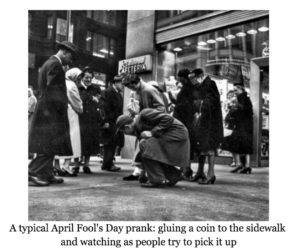“Lord what a fool these mortals be”
A Midsummer Night’s Dream by William Shakespeare
Although April Fools’ Day, also called All Fools’ Day, has been celebrated for several centuries by different cultures, its exact origins are shrouded in mystery. It is a day when humour, comedy and hi-jinx take center stage – but only until 12 midday – well at least that’s the rule in England – read on!
Theories abound on when we started to be pranksters for a day (half day in England!). Was it the changing of the calendar from Julian to Gregorian in the 16th Century, when the first day of the new year became 1st January instead of 1st April as it had been? Anyone slow on the uptake became the focus of others’ jokes.
Or was it linked as some historians have suggested to festivals such as Hilaria, celebrated in ancient Rome at the end of March which saw people dressing up in disguises?
Or possibly it was tied to the spring equinox, or first day of spring in the Northern Hemisphere, when Mother Nature fooled people with changing weather and climate
Wherever it came from, April Fools’ Day, as we know it, became popular throughout Britain during the 18th century. In Scotland, the tradition became a two-day event, starting with “hunting the gowk,” in which people were sent on phony errands (gowk is a word for cuckoo bird, a symbol for fool) and followed by Tailie Day, which involved pranks played on people’s backs, such as pinning fake tails or “kick me” signs on them.

In recent times people have put great effort into creating elaborate hoaxes for April 1st. Outrageous fictional claims have been concocted to fool the public by newspapers, radio, TV and websites.
The Rules of April Fools’ Day
The first of April is a time for light hearted humour, and pranks perpetrated on the day should reflect this. Ideally an April Fools’ Day prank should be funny to everyone involved when it’s all over. At least, that’s the goal.
The essence of an April 1st prank is to fool a victim. Therefore, pranks that involve no deception are considered out of place. Traditional April Fool pranks include gluing a coin to the pavement, putting salt in a sugar bowl, and tricking someone into believing their shoelaces are untied.
It’s perfectly acceptable (and probably desirable) for April Fools’ Day pranks to cause some inconvenience to victims. Making people feel embarrassed or irritated, wasting their time, making them do some work to undo the prank are all fair game. After all, the entire point of April Fools’ Day is to make people look foolish.
The line is, however drawn at inconvenience turning to actual violence or harm – as the phrase goes “No animal or person (or building or personal property) was harmed in the execution of this prank”
As a funny MC I sometimes get to play pranks on an unsuspecting client but only if I know they will take it well. The other day I was the host for an award ceremony in the construction industry. I found out that the man who was hosting with me – the Sales & Marketing Director no less – had once invented a pseudonym and it had become a popular in-joke, with his blessing.
I waited until about three-quarters of the way through the award ceremony and revealed that I knew what this other name was…to the extreme delight of the crowd. He laughed too.
The Midday Rule
This rule appears to be peculiar to English-speaking countries. The custom is that pranks can only be delivered until twelve o’clock noon. After that time, anyone who tries to play a prank is himself (or herself) the fool.
April 1 As An Unlucky Day
It’s an old superstition that April 1 is an unlucky day. This is often given implied to be for religious reasons. For instance, April 1 is said to be the birthday of Judas, or the day Judas hanged himself, or the day the devil was banished from Heaven.
April 1 was, for a long time, believed to be a bad day to schedule key events. Getting married for example on April 1 meant the couple would never be able to trust their spouse, condemning the marriage to failure. Or that a man who married on April 1 would always play second fiddle to his wife (and the point being made here is? – mental note to self to remember this one for my next comedy show!)
Children born on April 1 were thought to be unlucky children who would grow up unruly. Even the sinking of the Titanic has been attributed to the fact that its sea trials were due to be completed on April 1, 1912. (Although in fact the trials were actually delayed until April 2 due to strong winds.)
Of course, sometimes companies’ focus will not necessarily be a pure comedy – they will deliberately launch products on April 1 to defy convention and possibly gain a PR strike. The most famous example of this occurred on April 1, 2004 when Google announced its new Gmail email service, that came with a gigabyte of free storage. At the time, it was unheard of to offer so much free storage, so there was widespread speculation that the announcement was a hoax. This speculation was fueled by the fact that Google had already established a tradition of making spoof announcements on April 1.
Another famous April Fools’ Day launch occurred on April 1, 1976 when Apple Computer was founded by Steve Jobs, Steve Wozniak, and Ronald Wayne. According to histories of the company, this date was chosen quite deliberately as a way of saying “we want to be different”.
Whatever you do when you hear/read something that inspires a “surely not” response, just remind yourself of the date!
Happy April Fools’ Day!






Recent Comments